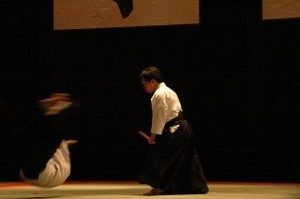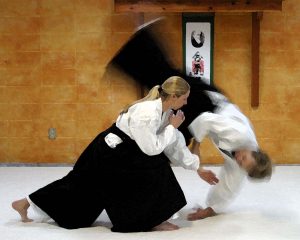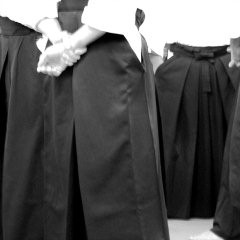1. Aikido: A Martial Way
To understand Aikido and its benefits, it must be said that as a traditional Japanese martial art, Aikido is more than simply an efficient method of self-defense. It is a form of Budo – a “martial way”. The word do in Japanese is the same as the Chinese word tao. It denotes a path of understanding, a way of life, and the Way of the universe itself.
 In Japanese history, as in many cultures, the warrior arts were considered uniquely suited not only for practical use during times of war, but for the refinement and development of the human character. The qualities and principles of the ideal warrior – courage, decisiveness, strength, clarity of mind, compassion – are also the ideal qualities of the human being. In this way, the Japanese martial tradition, like European chivalry, has always stressed the applicability of martial principles to daily life. This understanding is the meaning of budo. A related word, Bushido (“the way of the warrior”) also expresses this. A warrior’s way of life is not simply fighting, but is the constant striving for self-perfection in all things.
In Japanese history, as in many cultures, the warrior arts were considered uniquely suited not only for practical use during times of war, but for the refinement and development of the human character. The qualities and principles of the ideal warrior – courage, decisiveness, strength, clarity of mind, compassion – are also the ideal qualities of the human being. In this way, the Japanese martial tradition, like European chivalry, has always stressed the applicability of martial principles to daily life. This understanding is the meaning of budo. A related word, Bushido (“the way of the warrior”) also expresses this. A warrior’s way of life is not simply fighting, but is the constant striving for self-perfection in all things.
2. Physical Benefits
 Of course, the philosophy and internal benefits of Aikido are accompanied by concrete physical benefits. Aikido training is an excellent program for all-around physical fitness, flexibility, and relaxation.
Of course, the philosophy and internal benefits of Aikido are accompanied by concrete physical benefits. Aikido training is an excellent program for all-around physical fitness, flexibility, and relaxation.
The human body in general can exert power in two ways: contractive and expansive. Many fitness activities, for example weight-lifting, emphasize the former, which means that specific muscles or muscle groups are isolated and worked to improve tone, mass, and power. The disadvantage of this, however, is that whole body movement and coordination are rarely stressed. Thus, while muscle size and power may increase, there is no teaming of the ways in which to use those muscles together most efficiently. Also, this sort of training tends to increase tension, decrease flexibility, and stress the joints. The result may be aesthetically pleasing, but when done to excess it is ultimately useless, and actually detrimental to overall health.
The second type of power, expansive, is mostly stressed in activities such as dance or gymnastics. In these activities, the body must learn to move in a coordinated manner and with relaxation. Aikido, also, mostly stresses this sort of training.
While both types of power are important, it is interesting to note that a person who masters the second type of power can, in a martial context, often overcome a person who is much bigger or stronger. The reason for this is that the contractive power which most persons know is only as great as the mass and power of your individual muscles. Expansive power, however, as used in Aikido, can be much greater than your size may lead you to believe. This is because you move with your whole body.
Rather than stressing and tensing only a few muscles, you learn to relax and move from the center of your body, where you are most powerful. Power is then extended out naturally through the relaxed limbs, which become almost whip like in their motion.
So Aikido develops the body in a unique manner. Aerobic fitness is obtained through vigorous training. Flexibility of the joints and connective tissues is developed through various stretching exercises and through the techniques themselves. Relaxation is learned automatically, since without it the techniques will not function. And a balanced use of contractive and expansive power is mastered, enabling even a small person to generate enormous energy and self-defense skill.
3. Psychological Benefits
 Aikido training does not view the body and mind as separate. The condition of one will affect the other.
Aikido training does not view the body and mind as separate. The condition of one will affect the other.
For this reason, the physical relaxation learned in Aikido naturally becomes mental relaxation. Likewise, the perseverance and confidence that develop mentally are manifested in a body that moves and holds itself confidently and strongly. Any psychological or spiritual insight must be reflected in the body, or else it tends to be little more than intellectualization; under pressure, such insights disappear, and the person reverts to previously ingrained habits and patterns.
Aikido training requires the student to squarely face conflict, not to run away from it. Through this very concrete, physical experience, an Aikido practitioner learns to face the situations of life in a proactive, constructive manner. Patterns of avoidance and fear are broken. The tense, defensive reactions to pressure and conflict which so often only create more violence are recognized and deconstructed. A new person – straightforward, brave yet humble, able to be both strong and yielding as circumstances require – can emerge from this training.
Today, Aikido has become known in psychological and business circles as a highly useful metaphor in devising conflict resolution strategies. People everywhere are using Aikido philosophy to improve the quality of their lives.
4. Self-Defense
In Japan, a nation of many martial arts, Aikido is the one chosen for instruction to the elite Tokyo Metropolitan Riot Police and Secret Police. The reason for this may be the extreme flexibility inherent in the art.
 Unlike other arts, Aikido technique can be applied at varying levels of severity, in a continuum from the most gentle controlling techniques to the most severe countermeasures. Aikido is therefore ideal for application to a wide range of defensive situations, including law-enforcement/security/corrections, medical/mental-health environments, civilian self-defense, women’s self-defense, and children’s self- defense.
Unlike other arts, Aikido technique can be applied at varying levels of severity, in a continuum from the most gentle controlling techniques to the most severe countermeasures. Aikido is therefore ideal for application to a wide range of defensive situations, including law-enforcement/security/corrections, medical/mental-health environments, civilian self-defense, women’s self-defense, and children’s self- defense.
Aikido can be flexibly adapted to whatever situation arises; this is the legacy of the samurai, who devised these techniques to face a bewildering array of assaults by single or multiple attackers. Today, we continue this tradition by instructing Aikido and specialized Aikido-derived technique to a wide-range of organizations which need decisive, effective defensive skills.
5. Aikido in Daily Life
The practice of Aikido ultimately must become the practice of our daily lives, moment to moment. Every moment of life involves some sort of conflict – with others, with our environments, with our bodies, with ourselves. And yet, it is our choice to see this conflict as something to be avoided and struggled with, or as the creative force of change which makes true growth and learning possible.
 In order to develop the true human potential, some sort of discipline and refinement is necessary. In order to develop awareness, decisiveness, inner power and compassion, we must experience the hardship and work of facing life squarely. Life itself must be used to forge ourselves. This philosophy of Aikido means that, ultimately, our dojo (training hall) is much more than a building where we practice. Our true dojo is our life itself. And, Aikido consists of a unified training methodology designed to bring about this realization and put it to good use.
In order to develop the true human potential, some sort of discipline and refinement is necessary. In order to develop awareness, decisiveness, inner power and compassion, we must experience the hardship and work of facing life squarely. Life itself must be used to forge ourselves. This philosophy of Aikido means that, ultimately, our dojo (training hall) is much more than a building where we practice. Our true dojo is our life itself. And, Aikido consists of a unified training methodology designed to bring about this realization and put it to good use.
Viewed in this way, life becomes rich and filled with meaning. Every situation is used as a springboard to greater growth. We learn to open ourselves to experience, rather than shunning unpleasant aspects of life. Our minds expand, and we become strong.
This is the legacy of the martial ways, and the true value of Aikido training. The dream of O-Sensei was of all the peoples of the world, training together in peace for mutual benefit. Stressing the positive values of the martial ways, Aikido continues to grow and spread across the globe, fulfilling this vision.

